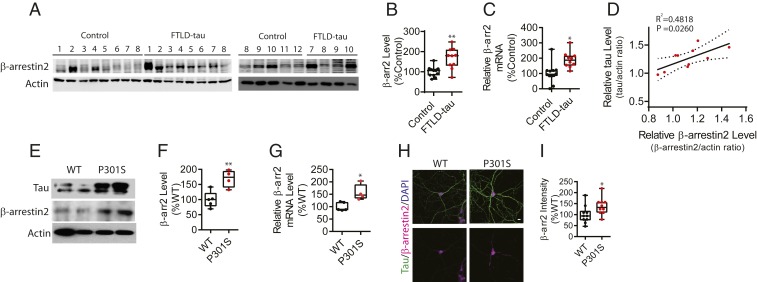Fig. 1.
β-Arrestin2 is increased in brains of FTLD-tau patients and tau P301S transgenic mice. (A) Representative immunoblots of β-arrestin2 from the frontal cortex of 12 age-matched unaffected controls and 10 FTLD-tau patients. The numbers above the lanes are sample numbers corresponding to the subjects, with some samples repeated on the second gel. (B and C) Quantification of β-arrestin2 protein and mRNA levels in the frontal cortex of FTLD-tau patients compared with unaffected controls (n = 12 healthy control, n = 10 FTLD-tau, **P < 0.005, *P < 0.05). (D) Correlation of insoluble tau and β-arrestin2 expression in FTLD-tau patients (n = 10 FTLD-tau). Each data point represents mean results from duplicate determinations from a given subject. The blots are shown in SI Appendix, Fig. S1. (E) Representative immunoblots of β-arrestin2 in the mouse cortex from 7-mo-old WT and tau P301S transgenic littermates. (F and G) Quantification of β-arrestin2 protein and mRNA levels in the cortex of WT and tau P301S transgenic littermates (n = 5 WT, n = 4 tau P301S, **P < 0.005, *P < 0.05). (H) Representative staining of β-arrestin2 (magenta) and total tau (green) using DIV21 hippocampal primary neurons derived from WT and tau P301S littermates. (Scale bar: 10 µm.) (I) Quantification of β-arrestin2 immunoreactivity (n = 3 independent experiments, *P < 0.05).

